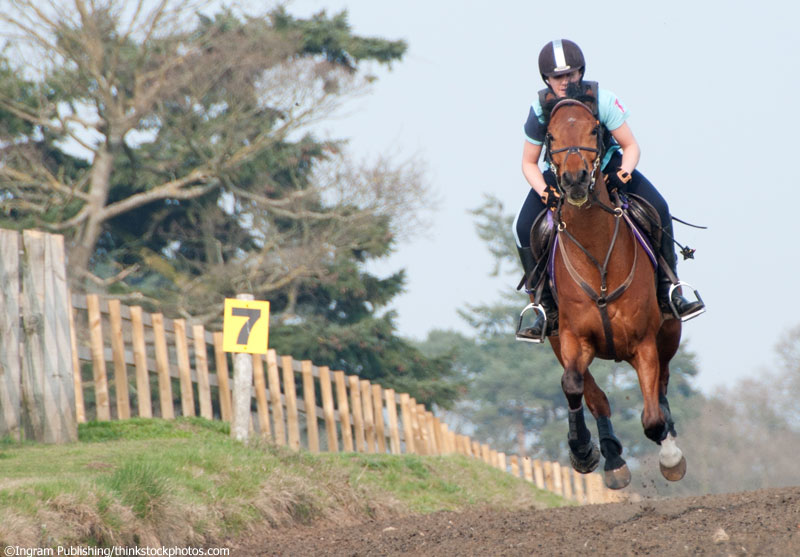
Effective riding requires fitness. Here’s how to maintain strength and endurance even when you can’t ride every day.
When life interferes and riding time gets reduced, there are ways to keep yourself in riding shape. The following suggestions are time-tested and proven to maximize your riding experiences even following a layup or downtime. First of all, we must acknowledge that most of daily life does not utilize the same recruitment of muscles used in a correct riding posture. In particular, the muscles that stabilize the pelvis and adduct the legs are rarely used during ordinary life unless a person practices a lot of yoga or Pilates. When these areas are weak, a rider will feel disorganized in the saddle, not to mention a little sore the following day!
Rule #1: Remember Cardio
Do yourself and your horse a favor during periods of less riding by vowing to get at least 30 minutes of cardiovascular exercise daily. Keeping your aerobic system conditioned will greatly ease your transition back to active riding. It will give you much greater stamina when you ride again, allowing you to stay balanced and energetic when trotting and cantering. This means less of a burden for your horse. It also means that, without becoming winded, you will be able to ride more effectively and therefore bring your horse back in to shape, as well. Too many riders underestimate the value of a good baseline of aerobic fitness.
I always advise riders to keep their exercise simple. Get out and power walk or hike for 30 minutes a day. This is all you need. Do not feel like you need to join a gym or buy fancy equipment or hire a personal trainer. Just get outside and move your legs and stretch your lungs for 30 uninterrupted minutes. Keep it simple, but be consistent. You will need to exercise four to five days a week to achieve a good baseline.
Rule #2: Keep your Riding Seat Tuned with Calisthenics
Over my years of both training horses and working out, I have found the following leg exercises to be among the most effective for maintaining riding fitness when students are not able to ride. They are quick and easy to do almost anywhere. They strengthen the muscles stabilizing your pelvis, alleviate disparities of strength between your legs, and improve balance. Again, I want to emphasize here that with consistency to these simple exercises, you will witness results. You will not need to tackle more complicated exercises or ones requiring a lot of expensive equipment. All you need for this routine is a Pilates band (a wide rubber band usually measuring 4 to 6 feet in length), which you can find at a drug store or in the fitness section of your department store.
With each of your legs, you will complete the following four maneuvers, executing 20 repetitions for each maneuver. Begin by tying the two ends of your Pilates band together so that it now forms a large circle. Now loop one end of the band around something sturdy like the leg of a couch, a fence post, mailbox (I use one of the legs on my bed). Place your right ankle inside the other end of the loop standing at a distance to maintain some tension in the band. Now stand up tall with the feeling of lightly engaging your abdominals, feet at hip’s distance apart.
Adduct: Begin by adducting your right leg, pulling on the band as you bring your right heel to touch your left ankle. Repeat this twenty times.
Abduct: Now turn 180-degrees so that you are facing the opposite direction and the band is looped around the outside of your right ankle. Standing up straight, now push your leg outward from your body, pulling against the band. Repeat twenty times.
Quads: Now turn to the right 90-degrees so that you are facing directly away from the fixed object around which your band is looped. The band will be on the front of your ankle now. Keeping your knee straight, now push your leg as far forward as you can, pulling against the band. You will feel your thighs working here. Repeat 20 times.
Hamstrings: Rotate 180-degrees so you are now directly facing the object around which your band is looped. The band will be around the outside of your ankle. Now kick your leg backwards, again keeping your knee straight, as far as possible, pulling against the band in long smooth movements. You will feel this in your hamstrings and possibly also up under your buttocks.
Repeat entire sequence on the left leg, noting any differences between your two legs and striving to equalize your effort and range of motion on both sides. The entire routine takes about three minutes and can be done while you’re brushing your teeth, on the phone, or just plain daydreaming. You have my word: if you follow these simple, easy to follow guidelines during periods of less riding, you will be much better off when you get back in the saddle!
Liked this article? Here’s more on fitness for riders:
HorseChannel’s Guide to Equestrian Fitness






Good advise, and I will have to try some of it.
cool
Great advice. And as you mentioned with the 30 minutes of walking, a little exercise is always better than nothing!
thanks for posting HC!
cool